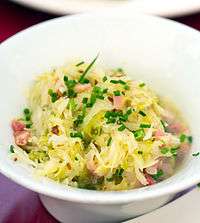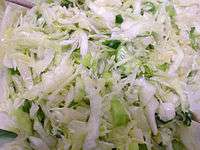Coleslaw
|
Coleslaw made with mayonnaise | |
| Alternative names | Slaw |
|---|---|
| Type | Salad |
| Course | Side dish |
| Place of origin | Netherlands[1] |
| Main ingredients | Fine shredded raw cabbage; vinaigrette (acetic acid (vinegar essence) or vinegar, vegetable oil, salt) or mayonnaise and salad cream |
|
| |
Coleslaw (also known as cole slaw or simply slaw) is a salad consisting primarily of finely-shredded raw cabbage[2] and dressed most commonly with a vinaigrette salad dressing. Prepared in this manner, coleslaw can be pickled for up to four weeks if it is stored in an airtight container.[3] Another way to make coleslaw is to use foods that already contain vinaigrette: mayonnaise, for example, is commonly used.
Coleslaw is frequently served as a side dish in many traditional meals across the world, and can be seen in major fast food chains as well.
Cabbage salad variations
There are many variations of the recipe, which include the addition of other ingredients such as red cabbage, pepper, shredded carrots, onion, grated cheese, pineapple, or apple, mixed with a salad dressing such as mayonnaise or cream. A variety of seasonings, such as celery seed, may be added. The cabbage may come in finely minced pieces, shredded strips, or small squares. Other slaw variants include broccoli slaw, which uses shredded raw broccoli in place of the cabbage. Cream, sour cream, or buttermilk are also popular additions. Buttermilk coleslaw is most commonly found in the southern United States.
Germany
Traditional German coleslaw ("Krautsalat") consists of finely shredded cabbage marinated with oil and vinegar. Sometimes onions or apples are added.
Italy
Coleslaw with cooked ham and sliced pepper (julienne cut) in Italy is called "Insalata Capricciosa" (capricious salad).
Russia and Ukraine
In Russia and Ukraine, a salad of fresh shredded cabbage, mixed with carrots, apples, cranberries etc., is traditionally dressed with unrefined sunflower oil. The cabbage can be priorly marinated with vinegar producing cabbage provençal (Russian: капуста провансаль, tr. kapusta provansal).[4] A similar salad is also made of sauerkraut.
Sweden
In Sweden, a particular type of cabbage salad made with a vinaigrette consisting of vinegar or acetic acid (vinegar essence), vegetable oil, salt, and seasonings is classically served with pizza and known as pizzasallad (pizza salad).[5] Recipe adds carrots and leeks and is called veckosallad (week salad) for its notable durability. The term coleslaw is reserved for cabbage salad with carrots and mayonnaise-based dressing, and is typically seen as part of the American cuisine.
United Kingdom
In the United Kingdom, coleslaw almost always contains carrot and onion in addition to cabbage, usually being made with mayonnaise, salad cream, or a mixture of the two. Some variations include nuts such as walnuts and dried fruits such as sultanas or raisins.
United States
In the United States, coleslaw often contains buttermilk, mayonnaise or mayonnaise substitutes, and carrot, although many regional variations exist, and recipes incorporating prepared mustard or vinegar without the dairy and mayonnaise are also common. Barbecue slaw, also known as red slaw, is made using ketchup and vinegar rather than mayonnaise.[6] It is an essential part of "Lexington style" North Carolina barbecue.[7]
Use
Coleslaw is generally eaten as a side dish with foods such as fried chicken and barbecued meats and may be accompanied by French fries or potato salad as another side dish. It also may be used as a sandwich ingredient, being placed on barbecue sandwiches, hamburgers, and hot dogs along with chili and hot mustard. A vinegar-based coleslaw is the signature ingredient to a Primanti Brothers sandwich. Coleslaw also is used on a variant of the Reuben sandwich, with coleslaw substituting for the sauerkraut; the sandwich is commonly called a Rachel to differentiate it from the Reuben.
Health effects
Vegan coleslaw has an extremely low glycemic index (cabbage 10) and glycemic load (cabbage 0.58) and is rich in fiber.[8]
Eating too much cabbage may lead to increased intestinal gas which causes bloating and flatulence due to the trisaccharide raffinose, which the small intestines cannot break down.[9][10][11] Insoluble fiber in cabbage increases the movement of waste in the digestive tract. Its excessive consumption may cause diarrhea or blockage of intestines.[11]
History
The term "coleslaw" arose in the 18th century as an anglicisation of the Dutch term "koolsla" ("kool" in Dutch sounds like "cole") meaning "cabbage salad".[12][13]
The 1770 recipe book The Sensible Cook: Dutch Foodways in the Old and New World contains a recipe attributed to the author's Dutch landlady, who mixed thin strips of cabbage with melted butter, vinegar, and oil. The recipe for coleslaw as it is most commonly prepared is fairly young, as mayonnaise was invented during the mid-18th century.
According to The Joy of Cooking (1997), raw cabbage is the only entirely consistent ingredient in coleslaw; the type of cabbage, dressing, and added ingredients vary widely. Vinaigrette, mayonnaise, and sour cream based dressings are all listed; bacon, carrots, bell peppers, pineapple, pickles, onions, and herbs are specifically mentioned as possible added ingredients.[13]
See also
References
- ↑ Engelhardt, Elizabeth (2009). Republic of barbecue : stories beyond the brisket. Austin: University of Texas Press. p. 17. ISBN 0292719981.
- ↑ "Coleslaw – Definition and More from the Free Merriam-Webster Dictionary". Merriam Webster. Retrieved August 2011. Check date values in:
|access-date=(help) - ↑ "Pickled Cabbage Salad".
- ↑ Alexandra Grigorieva (2010). Richard Hosking, ed. "Russian Food Words at Home and Abroad". Food and Language: Proceedings of the Oxford Symposium on Food and Cooking 2009. Oxford Symposium: 149. ISBN 9781903018798.
- ↑ "Pizzasallad - Recept från Spisa.nu".
- ↑ ABC News, (2009-06-05). "Lexington Red Slaw" WLS-TV/DT Chicago, IL. Accessed 2009-06-24.
- ↑ Mercuri, Becky (2007-03-05). The Great American Hot Dog Book: Recipes and Side Dishes from Across America. Gibbs Smith. p. 76. ISBN 9781423600220. Retrieved 21 April 2012.
- ↑ Glycemic Index: From Research to Nutrition Recommendations?. Copenhagen: Nordic Council of Ministers. 2005. ISBN 92-893-1256-4. TemaNord2005:589.
- ↑ "The digestive system and gas". WebMD. Retrieved 24 June 2013.
- ↑ St. John, Tina (5 June 2011). "Can You Eat Too Much Sauerkraut?". Livestrong.com. Retrieved 24 June 2013.
- 1 2 Allen, Suzanne. "Healthy Eating: Negative Effects of Cabbage". sfgate.com. Retrieved 7 June 2015.
- ↑ Perelman, Deb. (2007-08-08) "Coleslaw: You Could Be a Star". NPR. Accessed 2009-06-24.
- 1 2 Rombauer, Irma S.; Becker, Marion Rombauer; Becker, Ethan (1997). Joy of Cooking. New York: Scribner. p. 222. ISBN 0684818701.
External links
-
 The dictionary definition of coleslaw at Wiktionary
The dictionary definition of coleslaw at Wiktionary

